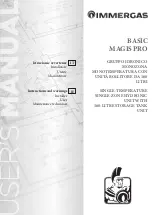
www.atmos.cz
18-GB
GB
Instruction manual - GB
for operation back-up of at least one pump. Another option is connecting the boiler to an
after-cooling tank and reversal zone valve. When installing the boiler, position the rear
section 10 mm higher in order to facilitate circulating and air-bleeding.
For the heating system regulation we recommend regulation elements provided by the
following companies:
For the control of the heating system we recommend the following controllers:
a) ATMOS ACD 01 - equithermal control set for solid fuel boilers
b) KOMEXTHERM, Praha
tel.: +420 235 313 284
c) KTR, Uherský Brod
tel.: +420 572 633 985
d) Landis & Staefa
tel.: +420 261 342 382
16. Boiler corrosion protection
The specified solution is connecting the boiler with a thermoregulatory valve or a three-way mix-
ing valve operated by a servo-drive, controlled by electronic regulation, which can separate the boiler
circuit from the heating circuit (primary and secondary circuits), and provide
minimum tempera-
ture of 65 - 75 °C for water returning to boiler.
The higher the temperature of water returning to the
boiler, the fewer tars and acids condensing. The tars and acids damage the boiler.
Temperature of the
outgoing water must permanently range between 80 - 90 °C.
The combustion products (waste gas)
temperature must not drop
below 110 °C
during normal operation. Low waste-gas temperature caus-
es condensation of tars and acids even when the specified outgoing water temperature of 80 - 90 °C
and returning water temperature of 65 °C are adhered to. These conditions may occur when using the
boiler to heat hot potable water (HPW) in summer, or when heating only a section of the building. In
this case we recommend connecting the boiler with accumulation tanks, or daily firing-up.
17. Specified boiler connection with thermoregulatory valve
and with an buffer tank
















































